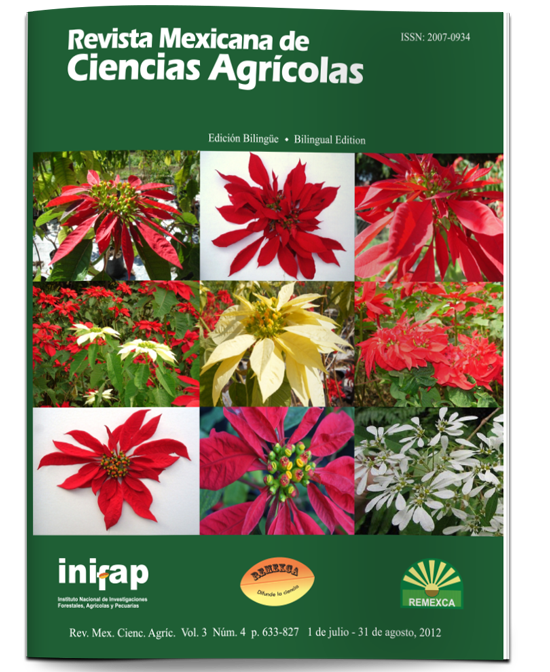Yield and reaction to diseases of bean genotypes under rainfed conditions and residual moisture
DOI:
https://doi.org/10.29312/remexca.v3i4.1426Keywords:
Phaseolus vulgaris L., environment, fungus, productivity, varieties, virusAbstract
In Chiapas, Veracruz and Puebla, diseases are one of the main factors that reduce the yield of beans. The objectives were to determine the productive performance of black bean genotypes in rainfed and residual moisture and, their reaction to disease. In 2008, a trial was made in Ocozocoautla, Chiapas, Orizaba, Veracruz and Tecamachalco, Puebla, in rainfed conditions and, in Medellín de Bravo and San Andrés Tuxtla, Veracruz, with residual moisture. 11 varieties and five lines were evaluated, in lattice design 4 x 4 with four replications. In field, the reaction was quantified to the common mosaic virus, angular leaf spot, rust and anthracnose, with a scale of 1 to 9 of CIAT and grain yield in kilograms per hectare.An analysis of variance was performed for each disease, which were correlated with grain yield, as well as combined analysis of genotypes yield for moisture condition and, overall analysis of all tested environments. For the separation of means DMS at 0.05 was applied. Negro Papaloapan yielded 1 753 kg ha-1 in rainfed and, 1 333 kg ha-1 with residual moisture; both average yields were statistically higher than the other genotypes. The incidence of anthracnose (r= -0516*) in the first condition and, angular leaf spot (r= -0528*) in the second one, significantly reducing its yield. Negro Papaloapan was the most productive in both conditions, and showed resistance to common mosaic, angular leaf spot and, anthracnose tolerance.
Downloads
Downloads
Published
How to Cite
Issue
Section
License
The authors who publish in Revista Mexicana de Ciencias Agrícolas accept the following conditions:
In accordance with copyright laws, Revista Mexicana de Ciencias Agrícolas recognizes and respects the authors’ moral right and ownership of property rights which will be transferred to the journal for dissemination in open access. Invariably, all the authors have to sign a letter of transfer of property rights and of originality of the article to Instituto Nacional de Investigaciones Forestales, Agrícolas y Pecuarias (INIFAP) [National Institute of Forestry, Agricultural and Livestock Research]. The author(s) must pay a fee for the reception of articles before proceeding to editorial review.
All the texts published by Revista Mexicana de Ciencias Agrícolas —with no exception— are distributed under a Creative Commons License Attribution-NonCommercial 4.0 International (CC BY-NC 4.0), which allows third parties to use the publication as long as the work’s authorship and its first publication in this journal are mentioned.
The author(s) can enter into independent and additional contractual agreements for the nonexclusive distribution of the version of the article published in Revista Mexicana de Ciencias Agrícolas (for example include it into an institutional repository or publish it in a book) as long as it is clearly and explicitly indicated that the work was published for the first time in Revista Mexicana de Ciencias Agrícolas.
For all the above, the authors shall send the Letter-transfer of Property Rights for the first publication duly filled in and signed by the author(s). This form must be sent as a PDF file to: revista_atm@yahoo.com.mx; cienciasagricola@inifap.gob.mx; remexca2017@gmail.
This work is licensed under a Creative Commons Attribution-Noncommercial 4.0 International license.



